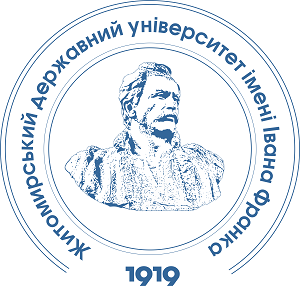THE INFLUENCE OF MICRONUTRIENT FERTILISERS AND GROWTH REGULATORS ON THE QUALITY PARAMETERS OF CORN GREEN BIOMASS
DOI:
https://doi.org/10.32782/naturaljournal.13.2025.22Keywords:
hybrid, chemical composition, gross energy, metabolizable energy, net energy for lactation (NEL), feed units, sugar contentAbstract
Determining the quality parameters of corn green biomass allows for an objective assessment of its nutritional and energy value for optimising animal feeding rations. It also serves as an important criterion for evaluating the quality of raw material, its suitability for ensiling, and the potential fermentation processes during storage. The aim of this study was to assess the influence of micronutrient fertilisers and plant growth regulators on the chemical composition, energy value, and ensiling suitability of corn hybrids’ green biomass.The application of micronutrient fertilisers and plant growth regulators affected the content of crude protein, crude fibre, cellulose, and starch in the corn green biomass. No significant impact was observed on the crude fat content, and no effect was found on the crude ash content. A strong positive correlation was established between crude protein and starch content (r = 0.98), crude protein and crude fat (r = 0.97), crude protein and cellulose (r = 0.96), as well as between crude fat and both starch and cellulose content (r = 0.98). The use of micronutrient fertilisers and plant growth regulators moderately increased acetic acid content and more significantly stimulated lactic acid accumulation in the corn green biomass. For the hybrids Gendalfand Intelligence, the highest values of gross energy, metabolizable energy, and net energy for lactation (NEL) were recorded in the third and fourth experimental variants – 18.79–19.09 MJ/kg, 10.55–10.89 MJ/kg, and 6.33–6.54 MJ/kg, respectively. At the same time, the content of feed units and energy feed units increased only slightly by 0.01–0.02 compared to the control.In terms of energy characteristics, the Intelligence hybrid significantly outperformed Gendalf.However, Gendalf showed better suitability of green biomass for ensiling based on sugar content, buffering capacity, and sugar-to-buffering-capacity ratio. While the use of micronutrient fertilisers and growth regulators in the Intelligence hybrid ensured a high sugar content, the sugar-to-buffering-capacity ratio was low, requiring more precise control of the fermentation process during silage preparation.
References
Гож О.А. Продуктивність гібридів кукурудзи залежно від мікродобрив та регуляторів росту на зрошуваних землях півдня України : автореф. дис. ... канд. с.-г. наук : 06.01.09 ; Херсонський державний аграрний університет. Херсон, 2016. 20 с.
Грабовський М.Б., Грабовська Т.О., Ященко С.А. Застосування препарату Ентеронормін у посівах кукурудзи. АгроТерра. 2020. № 1(8). С. 49–56.
Дехтяр З.М., Грицаєнко А.О., Карпенко В.К. Методи біологічних та агрохімічних досліджень рослин і ґрунтів. Київ : ЗАТ «Нічлава», 2003. 320 с.
Дехтяр Ю.Ф. Годівля тварин і технологія кормів : курс лекцій. Миколаїв : МНАУ, 2014. 129 с.
ДСТУ 46.045:2003. Зерно. Методи визначення умовної крохмалистості. Київ : Держспоживстандарт України, 2003. 20 с.
ДСТУ ISO 5983–2003. Визначення вмісту азоту і обчислення вмісту сирого білка методом К’єльдаля. Вид. офіц. Київ : Держспоживстандарт України, 2003. 18 с.
ДСТУ ISO 5984:2004. Визначення вмісту сирої золи. Вид. офіц. Київ : Держспоживстандарт України, 2005. 4 с.
ДСТУ ISO 6492–2003. Визначення вмісту жиру. Вид. офіц. Київ : Держспоживстандарт України, 2003. 19 с.
ДСТУ ISO 6865:2004. Визначення вмісту сирої клітковини методом проміжного фільтрування (ISO 6865:2000, IDT). Вид. офіц. Київ : Держспоживстандарт України, 2006. 14 с.
Костенко В.М., Панько В.В., Сироватко К.М. Практикум з годівлі сільськогосподарських тварин. Частина І «Хімічний склад, оцінка поживності та якості кормів». Вінниця : РВВ ВДАУ, 2008. 141 с.
Лебідь Є.М. Методика проведення польових дослідів з кукурудзою : методичні рекомендації. Дніпропетровськ, 2008. 27 с.
Мойсейченко В.Ф., Єщенко В.О. Основи наукових досліджень в агрономії. Київ : Вища школа, 1994. 334 с.
Павліченко К.В., Грабовський М.Б., Німенко С.С. Оцінка гібридів кукурудзи за якісними показниками зеленої маси. Матеріали XII Міжнародної науково-практичної конференції молодих вчених і спеціалістів «Селекція, генетика та технології вирощування сільськогосподарських культур», с. Центральне, 19 квітня 2024 р. : МІП ім. В. Я. Ремесла. С. 124.
Сатановська І.П. Використання регуляторів росту та хелатних добрив при формуванні продуктивності різностиглих гібридів кукурудзи на силос. Корми і кормовиробництво. 2013. Вип. 76. С. 218–224.
Allen M.S., Coors J.G., Roth G.W. Corn silage. Silage science and technology. 2003. Vol. 42. P. 547–608. https://doi.org/10.2134/agronmonogr42.c12.
Araújo K.G., Villela S.D.J., Leonel F.D.P., Costa P.M., Fernandes L.D.O., Tamy W.P., Andrade V.R. Yield and quality of silage of maize hybrids. Revista Brasileira de Zootecnia. 2012. Vol. 41. P. 1539–1544. https://doi.org/10.1590/S1516-35982012000600031.
Arriola K.G., Kim S.C., Huisden C.M., Adesogan A.T. Stay-green ranking and maturity of corn hybrids: 1. Effects on dry matter yield, nutritional value, fermentation characteristics, and aerobic stability of silage hybrids in Florida. Journal of Dairy Science. 2012. Vol. 95. № 2. P. 964–974. https://doi.org/10.3168/jds.2011-4524.
Baghdadi A., Balazadeh M., Kashani A., Golzardi F., Gholamhoseini M., Mehrnia M. Effect of presowing and nitrogen application on forage quality of silage corn. Agronomy Research. 2017. Vol. 15. № 1. P. 11–23.
Chornolata L., Zdor L., Lykhach S., Honchar L. Features of the carbohydrate composition of the silage corn hybrids green mass. Feeds and Feed Production. 2025. № 99. P. 171–180. ttps://orcid.org/0000-0002-6970-2233.
Erenstein O. The evolving maize sector in Asia: Challenges and opportunities. Journal of New Seeds. 2010. Vol. 11. P. 1–15. https://doi.org/10.1007/s12571-022-01288-7.
Erenstein O., Jaleta M., Sonder K., Mottaleb K., Prasanna B. M. Global maize production, consumption and trade: trends and R&D implications. Food Security. 2022. Vol. 14. № 5. P. 1295–1319. https://doi.org/10.1007/s12571-022-01288-7.
FAOStat. FAO, Rome. 2021. URL: http://www.fao.org/faostat (дата звернення 10.07.2025)
Ferraretto L.F., Shaver R.D., Luck B.D. Silage review: Recent advances and future technologies for whole-plant and fractionated corn silage harvesting. Journal of Dairy Science. 2018. Vol. 101. № 5. P. 3937–3951. https://doi.org/10.3168/jds.2017-13728.
Grabovskyi M., Kucheruk P., Pavlichenko K., Roubík H. Influence of macronutrients and micronutrients on maize hybrids for biogas production. Environmental Science and Pollution Research. 2023. Vol. 30. P. 70022–70038. https://doi.org/10.1007/s11356-023-27235-3.
Grote U., Fasse A., Nguyen T., Erenstein O. Food security and the dynamics of wheat and maize value chains in Africa and Asia. Frontiers in Sustainable Food Systems. 2021. Vol. 4. 617009. https://doi.org/10.3389/fsufs.2020.617009.
Khan N.A., Yu.P., Ali M., Cone J.W., Hendriks W.H. Nutritive value of maize silage in relation to dairy cow performance and milk quality. Journal of the Science of Food and Agriculture. 2015. Vol. 95. № 2. P. 238–252. https://doi.org/10.1002/jsfa.6703.
Lamptey S., Yeboah S., Li L. Response of maize forage yield and quality to nitrogen fertilization and harvest time in semi-arid Northwest China. Asian Journal of Research in Agriculture and Forestry. 2018. Vol. 1. № 2. P. 1–10. https://doi.org/10.9734/AJRAF/2018/40968.
Mandić V., Bijelić Z., Krnjaja V., Simić A., Petričević M., Mićić N., Caro P. V. Effect of harvesting time on forage yield and quality of maize. Biotechnology in Animal Husbandry. 2018. Vol. 34. № 3. P. 345–353. https://doi.org/10.2298/BAH1803345M.
Poole N., Donovan J., Erenstein O. Agri-nutrition research: Revisiting the contribution of maize and wheat to human nutrition and health. Food Policy. 2021. Vol. 100. 101976. https://doi.org/10.1016/j.foodpol.2020.101976.
Ranum P., Peña-Rosas J.P., Garcia-Casal M.N. Global maize production, utilization, and consumption. Annals of the New York Academy of Sciences. 2014. Vol. 1312. P. 105–112. https://doi.org/10.1111/nyas.12396.
Shiferaw B., Prasanna B., Hellin J., Banziger M. Crops that feed the world 6. Past successes and future challenges to the role played by maize in global food security. Food Security. 2011. Vol. 3. P. 307–327. https://doi.org/10.1007/s12571-011-0140-5
Shynkaruk L., Lykhochvor V. Influence of fertilization and foliar feeding on maize grain qualitative indicators. Ukrainian Journal of Ecology. 2021. Vol. 11. № 6. P. 113–116. https://doi.org/10.15421/2021_232.
Tsyliuryk O., Izhboldin O., Sologub I. Efficiency of growth regulators in corn crops of the Northern Steppe of Ukraine. Scientific Horizons. 2023. Vol. 26. № 10. P. 59–67. https://doi.org/10.48077/scihor10.2023.59.
Zaragoza E.J., Tadeo R.M., Espinosa C.A., López L.C., García E.J.C., Zamudio G.B., Turrent F.A., Rosado N.F. Rendimiento y calidad de forraje de híbridos de maíz en Valles Altos de México. Revista Mexicana de Ciencias Agrícolas. 2019. Vol. 10. № 1. P. 101–111. https://doi.org/10.29312/remexca.v10i1.1403.







